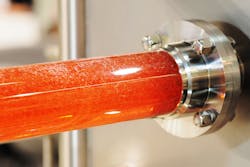How to Prevent or Minimize Air Entrapment in Industrial Fluids
Air bubbles can have a devastating impact on production. Medium viscosity adhesives, silicone, UV, epoxies, latex, and oil are just some of the fluids that are particularly affected. Trapped gasses can ruin the fluid or the part it is dispensed onto costing tens of thousands of pounds in lost production time. In the electronics industry, where epoxy resin encapsulation or coating is often an essential process, air bubbles lead to catastrophic parts failure. There are, however, some simple steps that can be taken to avoid or greatly minimize the chances of gas entrapment in industrial fluids.
1. Avoid Excess Fluid
Fluids change over time and the shifting chemical composition can itself cause air bubbles to form. Production managers using too much fluid will often find that its properties have changed significantly after just a few short days, with production processes having to be altered to suit and then re-altered to accommodate a fresh batch of fluid—whereupon the process starts all over again. The best practice is to use just the amount of fluid needed for a single production day. This de-risks the likelihood of air bubbles and also reduces lost production time by preventing the need to continually adapt production processes to the changing properties of the fluid.
2. Size Matters
One of the issues many production managers encounter, particularly those using legacy equipment, is the sheer size and capacity of vessels. This can often leave operatives having to manage four or even nine times the amount of air to fluid needed in a five or 10-liter tank. A smaller one or 2-liter vessel adapted to the daily volume usage minimizes the likelihood of air bubble contamination inside the fluid.
3. Under Pressure
Pressure requirements change over time in line with the amount of fluid used. The pressure set by the operator at the start of production with a full tank to deliver a certain size deposit will have changed significantly halfway through the production period. As the volume of fluid goes down, the volume of air grows with operators increasing the air pressure inside the vessel to compensate for the flow rate and achieve the desired deposit size. A sudden burst of air entering the pressurized tank at force, however, can penetrate the liquid causing air bubbles. The absolute best way of addressing this is to make use of an automated system that gradually adjusts the pressure in line with the volume of fluid used—ensuring consistent flow rates and deposits throughout production. If for any reason this cannot be done, however, a simple and effective way of reducing (but not eliminating) the formation of air bubbles is to install an elbow fitting to deflect the air jet onto the side of the fluid container.
4. Managing the Levels
Another common cause of air bubbles is too little fluid in the pressure tank. On automated or fast-moving production lines, the level of fluid can inadvertently drop below the dip tube. Air then enters the dip tube traveling through the feed line to the dispensing/spraying head. Using a level sensor will prevent the system from getting to this point avoiding a full production reset. Other methods include assessing levels by eye, something that has been made a lot easier following the commercial availability of transparent pressure vessels or weight monitoring.
5. From R&D to Full Production—Is This Fluid Right for Me?
Often in applications requiring adhesives such as cyanoacrylate, the wrong adhesive is selected for the application. Whilst perfectly capable of doing the job it was selected for at the research and development stage, multiplying that many times over to get to full capacity (e.g 1 part/day produced vs 100 parts/day produced) can often lead to a number of problems including the production of air bubbles. In some cases, this may mean going back to the drawing board and identifying a new adhesive or other industrial fluid. If this isn’t possible, then having complete control of the environment the fluid is in during production using some of the steps mentioned above can lead to a custom solution that enables the fluid to meet application and production requirements.
6. Chemical Compatibility
Often overlooked, but something to consider when other lines of inquiry have been pursued is whether fluids are reacting with any wetted parts to create gas bubbles? Sterile production systems with limited components are the best practice for any process involving fluids. A chemical reaction can cause chemicals and air to leach in and out of fluids.
7. System Setup
There are a number of practical steps that can be undertaken to minimize the likelihood of the formation of air bubbles at the system setup stage. Minimizing the distance between the fluid container and the dispensing/spraying head is one, along with considering pressure and flow rate and how everything is connected to the compressed air. One simple area that is often overlooked however is the fluid tubing itself. If too long, with an oversized diameter, there is a risk for loops, high points, and low points, that can cause air bubbles to be formed and dragged through the system by the fluid.
8. Fluid Transfer
The movement of fluid from one container to another can absolutely cause air bubble entrapment. Depending on the fluid viscosity trapped gas may raise to the surface over time, but this is not guaranteed. Attention should always be given to the manufacturer's advice on the best process and systems for storage and handling. However, as a rule of thumb, dispensing directly into the pressure vessel is often the best approach. In some cases, the production chamber can also be placed into a vacuum or centrifuge to remove bubbles ahead of production.
To find out more about effective fluid management visit: www.smartreservoirs.com

